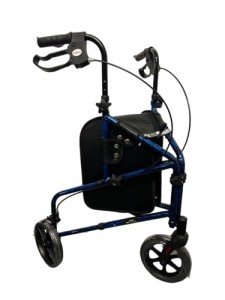Understanding Adjustable Walkers: A Comprehensive Guide
Adjustable walkers are vital mobility aids developed to supply stability and assistance to individuals with mobility obstacles. They improve independence, safety, and self-confidence for people recuperating from surgical treatment, dealing with persistent conditions, or facing age-related mobility concerns. This short article explores the functions, types, benefits, and typical FAQs associated with adjustable walkers, using insights for possible users and caretakers.
What is an Adjustable Walker?
An adjustable walker is a mobility aid that usually features a Lightweight 3-Wheel Rollator for Easy Mobility frame with four legs, equipped with handgrips for assistance. It can be gotten used to accommodate various heights, ensuring users achieve a comfy wrist position while supporting their weight. Adjustable walkers can be found in different designs, each customized to specific needs.
Key Features of Adjustable Walkers
- Height Adjustment: Most adjustable walkers have telescoping legs, permitting users to quickly customize the height to fit their stature.
- Weight Capacity: Different designs accommodate differing weight limitations, accommodating a broad group.
- Foldability: Many walkers are collapsible, making them easy to store and transportation.
- Wheels vs. No Wheels: Some walkers come with wheels on the front legs, while others have a fundamental design without wheels, promoting stability.
- Additional Accessories: Walkers can typically be equipped with trays, baskets, or cup holders for added benefit.
| Feature | Description |
|---|---|
| Height Adjustment | Telescoping legs for personalized height settings |
| Weight Capacity | Differs by model, supporting various body weights |
| Foldability | Collapsible design for easy transportation and storage |
| Wheels | Available in both wheeled and non-wheeled options |
| Extra rollator Accessories | Trays, baskets, and cup holders for user convenience |
Kinds Of Adjustable Walkers
- Requirement Walkers: Traditional models with 4 legs. Best for those looking for maximum stability.
- Wheeled Walkers (Rollators): Walkers with 2 or more wheels, enabling easier maneuvering.
- Hemi Walkers: Designed for people with making use of one hand, including a single arm support for added stability.
- Infant Walkers: Specifically designed for infants discovering to walk, promoting safety and support during early mobility.
Benefits of Using Adjustable Walkers
Boost Independence
- Enhanced Mobility: Adjustable walkers enable users to navigate their environments with more ease and confidence, promoting a sense of self-reliance.
- Availability: With the best walker, users can preserve their way of life and take part in activities they delight in without help.
Injury Prevention
- Stability and Support: Walker users can maintain much better balance and prevent falls, which are particularly essential for seniors and people recovering from surgical treatment.
- Lowered Strain: Proper use of a walker can alleviate tension on joints and muscles, reducing the threat of injury throughout mobility.
Comfort and Customization
- Adjustable Settings: Walkers can be customized to each user's height and comfort, using a more tailored experience.
- Extra Features: Options for devices help in accommodating individual requirements, making it possible for users to carry items while moving.
Costs and Considerations
The rate of adjustable walkers varies depending on functions, materials, and brand. Here's an introduction of the average costs associated with various types:
| Walker Type | Average Cost |
|---|---|
| Requirement Walkers | ₤ 50 - ₤ 100 |
| Wheeled Walkers | ₤ 75 - ₤ 200 |
| Hemi Walkers | ₤ 60 - ₤ 150 |
| Child Walkers | ₤ 30 - ₤ 70 |
Regularly Asked Questions (FAQs)
1. How do I know which adjustable walker is best for me?
The right adjustable Lightweight Tri-Wheel Walker with Bag for Easy Mobility depends upon your specific needs, physical condition, and environment. It's necessary to speak with a healthcare expert to figure out the most appropriate type.
2. Can I change the height of any walker?
A lot of adjustable walkers include a height-adjustment system. Nevertheless, not all walkers are adjustable. It's important to take a look at item specifications before buying.
3. Are wheeled walkers safe to use?
Yes, wheeled walkers (or rollators) are safe for users who can browse them properly. They typically include brakes for added safety when stationary.
4. How do I care for my adjustable walker?
Regular care includes cleaning the walker with mild soap and water, looking for wear on grips and wheels, and ensuring systems operate efficiently.
5. Can I take my adjustable walker on public transportation?
Yes, numerous adjustable walkers are foldable and developed for simple transportation. However, it's a good idea to inspect the particular standards of the transportation service.

6. Do I require assistance to use an adjustable walker?
Many users can operate adjustable walkers individually, especially when properly fitted to their height. Nevertheless, those with serious mobility concerns may take advantage of help.
Adjustable walkers are important tools for improving mobility, independence, and safety. With a variety of design and styles, individuals can find a walker customized to their needs. Caretakers and users alike must appreciate the significance of consulting health care professionals to make educated decisions relating to mobility aids. Understanding the functions, benefits, and factors to consider of adjustable walkers empowers individuals to keep an active way of life, improving their lifestyle in spite of mobility challenges.

